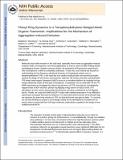Phenyl Ring Dynamics in a Tetraphenylethylene-Bridged Metal–Organic Framework: Implications for the Mechanism of Aggregation-Induced Emission
Author(s)
Ong, Ta-Chung; Michaelis, Vladimir K.; Shustova, Natalia; Cozzolino, Anthony Frank; Griffin, Robert Guy; Dinca, Mircea; ... Show more Show less
Downloaddinca_Phenyl ring.pdf (1.959Mb)
PUBLISHER_POLICY
Publisher Policy
Article is made available in accordance with the publisher's policy and may be subject to US copyright law. Please refer to the publisher's site for terms of use.
Terms of use
Metadata
Show full item recordAbstract
Molecules that exhibit emission in the solid state, especially those known as aggregation-induced emission (AIE) chromophores, have found applications in areas as varied as light-emitting diodes and biological sensors. Despite numerous studies, the mechanism of fluorescence quenching in AIE chromophores is still not completely understood. To this end, much interest has focused on understanding the low-frequency vibrational dynamics of prototypical systems, such as tetraphenylethylene (TPE), in the hope that such studies would provide more general principles toward the design of new sensors and electronic materials. We hereby show that a perdeuterated TPE-based metal–organic framework (MOF) serves as an excellent platform for studying the low-energy vibrational modes of AIE-type chromophores. In particular, we use solid-state [superscript 2]H and [superscript 13]C NMR experiments to investigate the phenyl ring dynamics of TPE cores that are coordinatively trapped inside a MOF and find a phenyl ring flipping energy barrier of 43(6) kJ/mol. DFT calculations are then used to deconvolute the electronic and steric contributions to this flipping barrier. Finally, we couple the NMR and DFT studies with variable-temperature X-ray diffraction experiments to propose that both the ethylenic C═C bond twist and the torsion of the phenyl rings are important for quenching emission in TPE, but that the former may gate the latter. To conclude, we use these findings to propose a set of design criteria for the development of tunable turn-on porous sensors constructed from AIE-type molecules, particularly as applied to the design of new multifunctional MOFs.
Date issued
2012-08Department
Massachusetts Institute of Technology. Department of Chemistry; Francis Bitter Magnet Laboratory (Massachusetts Institute of Technology)Journal
Journal of the American Chemical Society
Publisher
American Chemical Society (ACS)
Citation
Shustova, Natalia B., Ta-Chung Ong, Anthony F. Cozzolino, Vladimir K. Michaelis, Robert G. Griffin, and Mircea Dincă. “Phenyl Ring Dynamics in a Tetraphenylethylene-Bridged Metal–Organic Framework: Implications for the Mechanism of Aggregation-Induced Emission.” Journal of the American Chemical Society 134, no. 36 (September 12, 2012): 15061-15070.
Version: Author's final manuscript
ISSN
0002-7863
1520-5126